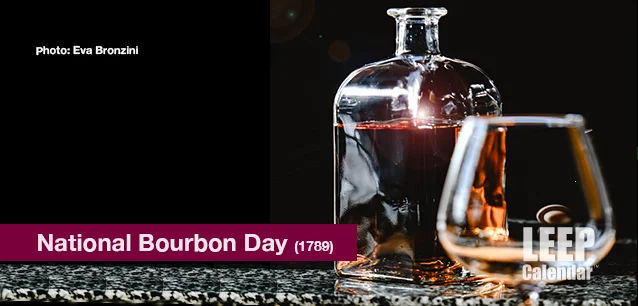 AD
AD
Today is: November 22
Scroll to explore events active on this date.
LEEP INK FEATURES

August is Appropos
A toddler playing in the fountain at a park in Santa Fe, New Mexico—Photo LD Lewis. In August, we live through the Dog Days of Summer. It's hot and often humid, and those ...

September is Sassy
Can you hear that sigh of relief from parents worldwide? Yes! September marks the return of students to school, a global phenomenon. Preparations for the ACT and SATs begin earnestly for ...

OOH LA LA, October
October is the busiest month for events, with 5% more happening than in May, the second most eventful month. Sailing enthusiasts will be glued to the finals of this year's Am...
About National Bourbon Day
United States
Ends: Jun 14, 2025
DESCRIPTION:
Bourbon Day marks the anniversary of the day Rev. Elijah Craig began distilling corn in Kentucky to produce bourbon in 1789. Bourbon is a 100% American invention, and the day is best celebrated neat or on the rocks.
HISTORY OF BOURBON
Bourbon's roots trace to the late 18th and early 19th centuries in the United States. The name "bourbon" comes from Bourbon County, a region in Kentucky at the time. Although the exact origins are undocumented, several key moments and people contributed to the development of bourbon as we know it today.
In the late 1700s, European settlers (primarily of Scots-Irish and English descent) moved into the western frontier of the United States, including Kentucky, bringing knowledge of distilling, which they adapted to the local ingredients—corn, rye, and barley. The limestone-filtered water in the region also played an essential role in bourbon production.
Elijah Craig, a Baptist minister, and distiller, is partly attributed to its creation. On June 14, 1789, he is said to have been the first to age whiskey in charred oak barrels, which imparted the distinct caramel and vanilla flavors characteristic of bourbon. This practice became a standard for bourbon production.
Bourbon County is not necessarily the birthplace of the spirit; however, it was a significant center for whiskey production and trade in the early 19th century. Whiskeys from this region found distribution on the Ohio and Mississippi Rivers in barrels marked "Bourbon," and the name stuck.
During the 1820s-1850s, bourbon production flourished, with many distilleries opening in Kentucky. The whiskey gained popularity in the southern United States and became known as a distinctly American spirit.
The American Civil War disrupted bourbon production, as many distilleries were destroyed or repurposed for the war effort. Following the war, the bourbon industry recovered and grew again.
The Bottled-in-Bond Act (1897) established strict regulations for producing and labeling "bonded" whiskey, including bourbon. To be labeled bottled-in-bond, a bourbon had to be made by a single distiller in a single distillation season, aged for at least four years in a government-bonded warehouse, and bottled at 100 proof (50 percent alcohol by volume) to ensure the quality and consistency of bourbon.
Prohibition (1920-1933), created with the passage of the 18th Amendment to the United States Constitution and the Volstead Act, effectively shut down the legal production and sale of alcoholic beverages, including bourbon. Some distilleries were allowed to continue production for medicinal purposes, but overall, the bourbon industry suffered greatly.
After the repeal of Prohibition in 1933, the bourbon industry slowly recovered. During World War II, many distilleries were repurposed to produce industrial alcohol, bourbon production increased, and the spirit regained popularity in the post-war years.
In the late 20th through the early 21st century, bourbon experienced a renaissance with the rise of craft distilleries and a renewed appreciation for the spirit's unique flavors and heritage. Bourbon has experienced increased global popularity, with enthusiasts enjoying its rich history and diverse flavors.
Bourbon's history intertwines with the history of the United States and remains an iconic and beloved American spirit.
VIDEOS
Currently, this event does not have supporting videos.
SUPPORTING DOCUMENTS
Currently, this event does not have supporting documents.
ADDITIONAL IMAGES
Currently, this event does not have supporting images.
Where would you like to go now?
 AD
AD


/footer-logo.svg)
